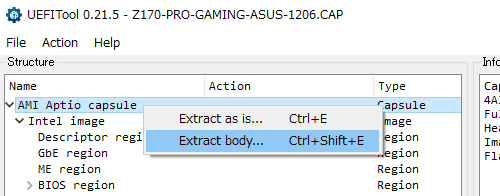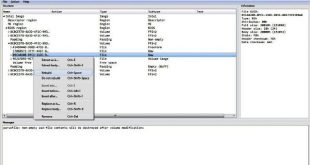
- Uefitool release software#
- Uefitool release download#
- Uefitool release free#
- Uefitool release windows#
# $Chocolate圜entralManagementUrl = " # ii. # If using CCM to manage Chocolatey, add the following: $ChocolateyDownloadUrl = "$($NugetRepositoryUrl.TrimEnd('/'))/package/chocolatey.1.2.1.nupkg"

Uefitool release download#
# This url should result in an immediate download when you navigate to it # $RequestArguments.Credential = $NugetRepositor圜redential # ("password" | ConvertTo-SecureString -AsPlainText -Force) # If required, add the repository access credential here $NugetRepositoryUrl = "INTERNAL REPO URL"

# Should be similar to what you see when you browse Your internal repository url (the main one). # We use this variable for future REST calls. ::SecurityProtocol = ::SecurityProtocol -bor 3072 # installed (.NET 4.5 is an in-place upgrade). NET 4.0, even though they are addressable if. # Use integers because the enumeration value for TLS 1.2 won't exist # Set TLS 1.2 (3072) as that is the minimum required by various up-to-date repositories. # We initialize a few things that are needed by this script - there are no other requirements. # You need to have downloaded the Chocolatey package as well. Download Chocolatey Package and Put on Internal Repository # # repositories and types from one server installation. # are repository servers and will give you the ability to manage multiple
Uefitool release software#
# Chocolatey Software recommends Nexus, Artifactory Pro, or ProGet as they # generally really quick to set up and there are quite a few options. # You'll need an internal/private cloud repository you can use. Internal/Private Cloud Repository Set Up # # Here are the requirements necessary to ensure this is successful. Your use of the packages on this site means you understand they are not supported or guaranteed in any way.
Uefitool release free#
With any edition of Chocolatey (including the free open source edition), you can host your own packages and cache or internalize existing community packages. Packages offered here are subject to distribution rights, which means they may need to reach out further to the internet to the official locations to download files at runtime.įortunately, distribution rights do not apply for internal use. If you are an organization using Chocolatey, we want your experience to be fully reliable.ĭue to the nature of this publicly offered repository, reliability cannot be guaranteed. Human moderators who give final review and sign off.Security, consistency, and quality checking.ModerationĮvery version of each package undergoes a rigorous moderation process before it goes live that typically includes:

It's also beneficial to those who wish to learn and practice handling this type of tool.Welcome to the Chocolatey Community Package Repository! The packages found in this section of the site are provided, maintained, and moderated by the community. UEFITool is a C++/Qt program for parsing, extracting and modifying UEFI firmware images. What's more, you'll be able to export any of your work quickly after you're finished. You'll have a basic user interface that easy to understand and navigate, making your job a lot easier. Easily change your UEFI firmwareįor those who find making UEFI changes tiresome and somewhat complicated, UEFITool will serve as an excellent solution for you. If you wish to seek other developers' feedback on the changes, you may also share it publicly.
Uefitool release windows#
After you have the necessary changes, you have the option to either save your BIOS images and UEFI firmware settings to your Windows device or an external USB drive as the last step. Images, such as BIN, BIO, ROM, CAP, WPH, FD, and EFI are some of the image types you can experiment with using this tool.Īs long as you know what you're doing, you can add and delete components as you see appropriate. UEFITool displays the data in an easy-to-read manner. Of course, before you can make any changes, you'll need to comprehend what you're looking at. The user-friendly UEFITool interface is the first component that makes UEFI-changing simple for you.Įverything is well laid out in windows where you can get all of the information you need to get you started. You'll just import files as images and make changes before exporting them again. The goal of UEFITool is to make the process easier by providing the best techniques for interpreting and changing settings without causing any harm. Working with BIOS settings may be challenging, especially if you're not familiar with the procedure.


 0 kommentar(er)
0 kommentar(er)
